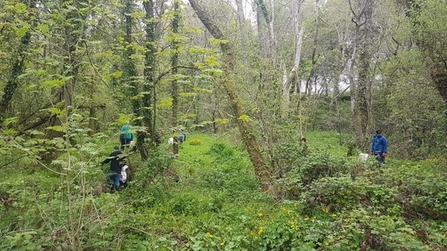We’ve arrived at the party early this year. On higher dry ground bluebells and wood anemones display their spring glory. In the low damp wet areas, the ground is brightly carpeted with opposite leaved golden saxifrage and creeping buttercup, marsh marigold bursts from the ground with its bright yellow flowers. With its deceptive leaf shape dogs mercury is present through the area. The work is light but not easy, the plants we’re pulling are small but there are many. Backs and knees are bent, the ground underfoot is unreliably soft. Our hands and arms snake between tree seedlings, fallen limbs and scratching bramble to reach the plant we need to pull. The mind wanders, its peaceful and you realise nobody in the group has spoken as the task is absorbing all thoughts. Then you hear one of the group say, “we’d be wealthy if we got paid a penny per plant”!
Himalayan Balsam in Gelli-Hir Wood
Volunteers in Gelli-Hir Wood begin this year's battle against Himalayan Balsam. The non-native invasive plant has begun its renewed attack on our woodland. On the front line are our volunteers, fighting for our native species.

We’re here in the wet woodland in the area around the streams and ponds in Gelli-Hir for the Himalayan balsam. Over the years repeated hand pulling or cutting where we can appears to be having a positive impact at reducing the dominance of this invasive plant. Balsam pulling season has begun for us in late April, there will be many more visits this summer. This is one of those habitat management tasks that need many hands, the volunteers are essential to this. So, a big thanks to our volunteer crew – after their efforts year on year we are seeing the results of repeated effort. They keep me motivated, they motivate each other and the riparian habitats within the reserve and downstream are benefitting.
